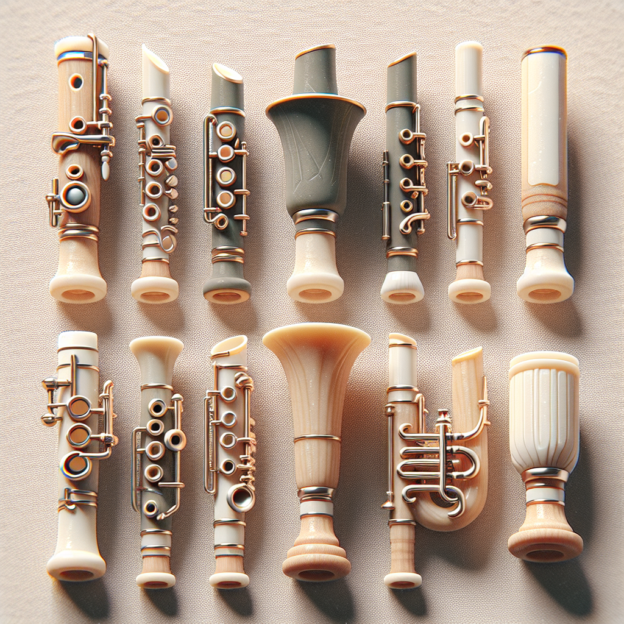The clarity and warmth of your clarinet tone depend heavily on an often-overlooked component: the mouthpiece. The material and acoustic properties of the clarinet mouthpiece significantly influence dynamics, response, and tonal character. Understanding and selecting your mouthpiece's material can greatly impact your performance.
This guide explores the most common types of mouthpiece materials and their impact on acoustic properties. Whether you're just starting out or a seasoned professional, you'll find valuable insights to enhance your playing experience.
The Role of Mouthpiece Material in Sound
The clarinet's sound originates at the mouthpiece, where the reed's vibration meets the mouthpiece's shape and resistance. Even minor changes in material can affect tone and feel, which is why manufacturers invest significant time in perfecting their designs.
Martin Freres Clarinets are known for their understanding of how materials affect playing. Their designs have long emphasized the balance between material science and player comfort.
| Material | Characteristics | Best Suited For |
|---|---|---|
| Ebonite (Hard Rubber) | Warm tonal qualities, smooth texture | Classical and jazz musicians |
| Crystal | Incredible clarity, excellent projection | Soloists and orchestral players |
| Metal | Brightness, edge, volume | Outdoor performances, larger ensembles |
| Lexan and Plastic | Affordable, durable | Beginners, students |
Ebonite (Hard Rubber): The Player's Choice
Ebonite is one of the most popular materials for clarinet mouthpieces. Players appreciate its warm tonal qualities and smooth texture. Ebonite mouthpieces offer a good balance of comfort and acoustic projection, and they're durable enough to withstand regular use without deteriorating.
Ebonite mouthpieces are known for their ability to influence sound depth. Many clarinetists using Martin Freres instruments notice how consistently ebonite supports detailed performance. Its response across registers makes it especially popular among classical and jazz musicians looking for rich resonance.
Crystal: Brightness and Clarity
Crystal mouthpieces, typically made from glass-like materials, are valued for their exceptional clarity. Players seeking precise articulation and tonal brightness often prefer crystal mouthpieces. The denser material offers excellent projection, making it popular among soloists and orchestral players.
However, crystal mouthpieces are fragile. Dropping one on a hard surface could mean an immediate replacement. Martin Freres Clarinets, known for their artistic designs, incorporate these premium acoustic properties in their professional ranges.
Metal: Power and Volume
Metal mouthpieces are primarily used by players who need volume and projection. While less common in clarinet playing compared to saxophone, they have a dedicated following. Metal adds brightness and edge to performances, making it suitable for outdoor settings or large ensemble performances.
However, some players find metal mouthpieces less comfortable than softer materials like ebonite. Martin Freres has invested years in understanding the relationship between functionality and ergonomic design, contributing to discussions on form and material.
Lexan and Plastic: Affordable but Functional
For beginners, plastic and Lexan mouthpieces offer an affordable starting point. While they may not have the responsiveness and tonal refinement of more expensive materials, they are affordable and durable. Many student models use these materials due to their forgiving nature in terms of both sound and durability.
While experienced players might not prefer these materials, they serve an important role in introducing new clarinetists to the instrument. Martin Freres student clarinets often come with such mouthpieces, offering exceptional playability without compromising on sound quality.
How Does Material Connect to Acoustic Properties?
The mouthpiece material doesn't work in isolation; it interacts with the internal chamber design, facing length, and reed compatibility. Together, these factors determine vibration, projection, and tone. Material density affects how vibrations travel through the mouthpiece, directly impacting the brightness or mellowness of notes. Generally, denser materials like crystal or metal amplify higher frequencies more readily, while softer materials like ebonite emphasize warmth and depth.
Next time you play your clarinet, consider if your mouthpiece aligns with your playing style and musical context.
Tips for Choosing the Right Material
Selecting the right material is crucial for your playing experience. Consider the type of music you play most often. Do you prefer soft, jazzy tones or brighter, more cutting sounds for concert performances? Choose a material that matches your tone preferences and performance needs.
It's beneficial to try several materials before making a decision. Clarinetists often discover their preferences through practice and experimentation. Even within a single brand like Martin Freres, you might find options that perfectly suit your individual style.
Remember to consider your reed and ligature setup as well. Your mouthpiece is part of a trio designed to create your best sound.
Caring for Your Clarinet Mouthpiece
Proper care extends the life of your mouthpiece and maintains its performance. Regular cleaning is essential. Warm water and mild soap are usually sufficient to prevent buildup that could affect playability. Use a soft brush or cloth for cleaning. For crystal or ebonite mouthpieces, avoid harsh chemicals that could damage the surface and affect the sound.
Be aware of temperature extremes. Leaving your clarinet in a hot car can warp materials or cause cracks, especially in crystal or metal mouthpieces. Always store your instrument in a protective case and handle it with care.
Your clarinet playing improves significantly when all these elements work together harmoniously, allowing you to achieve your unique, captivating sound. Mouthpieces, though often overlooked, are a crucial component of your sound. Whether you're performing in a school recital or a packed concert hall, it all starts with choosing the right mouthpiece and playing with confidence, as many have discovered with Martin Freres instruments.
Table of Contents
- Introduction
- The Role of Mouthpiece Material in Sound
- Ebonite (Hard Rubber): The Player's Choice
- Crystal: Brightness and Clarity
- Metal: Power and Volume
- Lexan and Plastic: Affordable but Functional
- How Does Material Connect to Acoustic Properties?
- Tips for Choosing the Right Material
- Caring for Your Clarinet Mouthpiece







